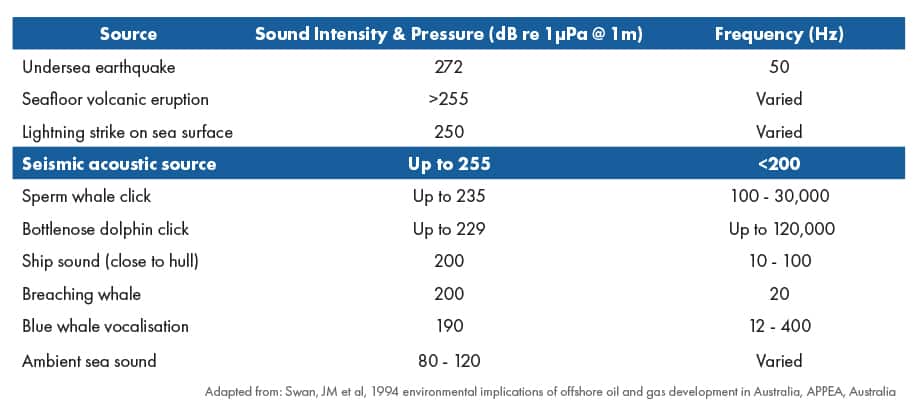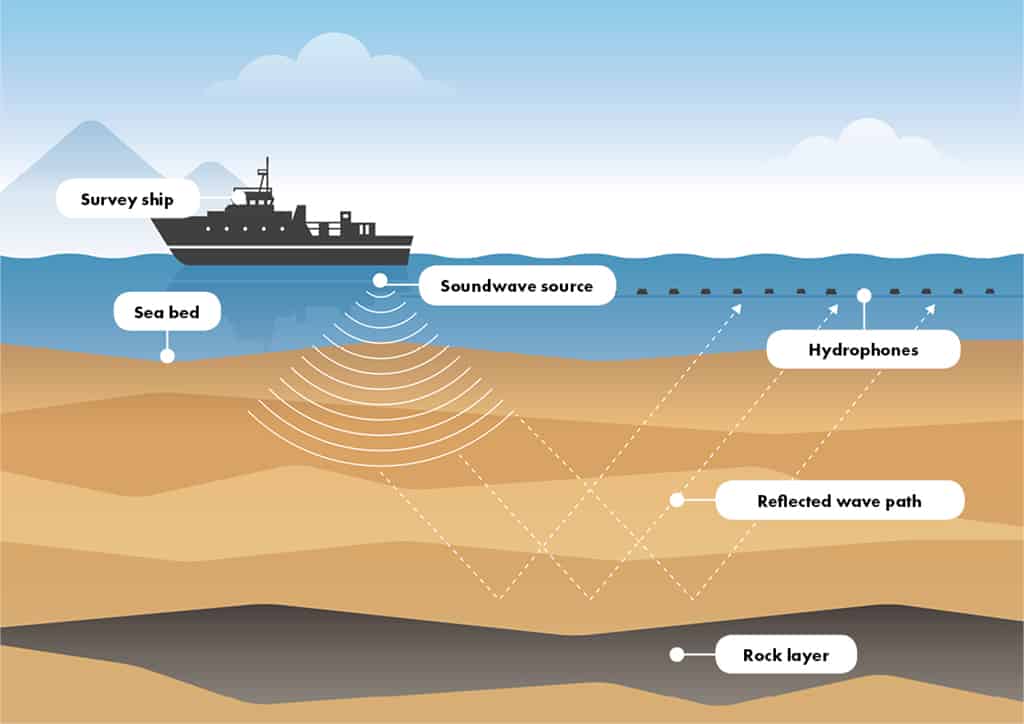Marine seismic surveys: what you need to know
A marine seismic survey is a method of determining geological features below the sea floor, using a technical process which involves sending sound waves into the rock layers beneath the sea floor and then recording the time is takes for each wave to bounce back as well as measuring the strength of each returning wave. It is the most reliable form of initial exploration for oil and gas and is an essential process in identifying geological features that could contain oil or gas deposits.
Is it safe for marine mammals?
Yes. Despite some confusion caused by anti-fossil fuel activists, multiple studies confirm that marine seismic surveys do not adversely impact whales or dolphins.
“The surveys were completed with no evidence of adverse effects on whales. The ‘song’ of the whales was recorded both during and after seismic was acquired and the results indicated that the whales continued to ‘sing’ during times when seismic data were being acquired, no avoidance or evasive behaviour was evident during the surveys.”
Humpback whales of the Perth Basin – Studies conducted during Roc Oil’s 2002 Seismic Program
“Roc Oil’s 2003 seismic survey program was completed with no detectable adverse effects to the whales’ migration.”
Humpback whales of the Perth Basin – Studies conducted during Roc Oil’s 2003 Seismic Program
“Given the relatively small scale of seismic activity, the often large scale over which biological events occur, and the low probability of encounter between seismic surveys and, at risk, populations at an appropriate time and place, then the wider implications of disruption by seismic surveys appear to be small for most species.”
Environmental Implications of Offshore Oil and Gas Development in Australia
“The observations indicated that during seismic recording, some species such as dolphins, sperm whales and pilot whales appeared to be relatively tolerant, often approaching within 3 km and in the case of dolphins, altering course to ride bow waves of the vessel while actively operating.”
Southern Margins Seismic Survey Programme
“The first major Australian study on the response of humpback whales to seismic surveys reported no major change in the migratory route of southbound whales off Western Australia during a 3D seismic survey.”
Centre for Marine Science and Technology, Curtin University
“To date, there has been no documented scientific evidence of noise from air guns used in geological and geophysical (G&G) seismic activities adversely affecting marine animal populations or coastal communities.”
The U.S. Bureau of Ocean Energy Management
Marine seismic surveys have been used off Australia’s coasts for more than 50 years, a period in which whale populations off the coast of Australia were steadily increasing as commercial whaling was increasingly restricted, and then banned. In fact, there has been significant press coverage of increasing whale populations in Australia’s waters.
The West Australian humpback whale population numbers are probably near to those of pre-whaling days (Bannister and Hedley, 2001). At approximately 22,000 individuals, plus or minus 8,000, Western Australia’s Breeding Group D population of Humpback whales is considered the world’s largest, co-existing with the oil and gas industry now for those 60 years.
“Western Australia’s whale populations appear to be in step with their east coast counterparts with large pods of humpbacks coming within metres of spectators off the southern coastlines.”
Humpbacks and southern right whales out in force off the WA coast, ABC News
“Queensland researchers say the current population of humpback whales is the highest ever recorded and they are concerned at the rapid rate at which the species is populating. Dr Michael Noad, from the University of Queensland’s Cetacean Ecology and Acoustics Laboratory, said the most recent figures in 2015 showed 24,500 whales were in the east coast humpback migratory population.”
Humpback whale population increasing ‘like crazy’, say scientists, ABC News
“Whale populations expected to migrate past the Gold Coast have boomed to an estimated 27,000 individuals, up from 20,000 three years ago.”
Whale populations off the Gold Coast boom to 27,000, but could there be a bust? Gold Coast Bulletin
Can seismic surveys impact the catch rate of fish?
Another concern among some individuals is that marine seismic surveys adversely impact local fishing industries. There has been no evidence to corroborate these claims. Seismic has been used for over 50 years in Australian waters, and fisheries in regions that host oil and gas activities continue to be some of the most productive in Australia.
“The project provided no clear evidence of adverse effects on scallops, fish, or commercial catch rates due to the 2015 seismic survey undertaken in the Gippsland Basin…The effects of seismic surveys on catch seem transitory and vary among studies, species, and gear types.”
Geoscience Australia
“The study has not clearly identified negative (or positive) effects of seismic surveys and subsequent fisheries catch rates identified by analysis conducted in the study.”
The Commonwealth Scientific and Industrial Research Organisation
“There were no clear or consistent relationships between seismic surveys and subsequent fisheries catch rates identified by analysis conducted in this study.”
The Commonwealth Scientific and Industrial Research Organisation
These Australia-specific scientific studies are supported by experiences in other countries. For example, Norway one of the world’s largest energy exporters, has been conducting marine seismic surveys since 1969 and has one of the most prolific commercial fishing industries.
How loud is a marine seismic survey?
The noise generated by marine seismic surveys is analogous to many naturally occurring marine sounds including those made by some animals themselves. For example, a sperm whale click has a sound intensity and pressure in the same range of a seismic acoustic source. We’ve provided a breakdown below:

Given the noise-level, marine seismic operators ramp-up slowly, over a period of thirty minutes, in order to give any wildlife that may be perturbed by it the opportunity to move away.
Operators engage independent Marine Mammal Observers (MMO), who are trained and experienced in whale identification and behaviour and distance estimation to make sure that no whales are in the area. The MMOs are also trained to provide advice should whales be encountered.


